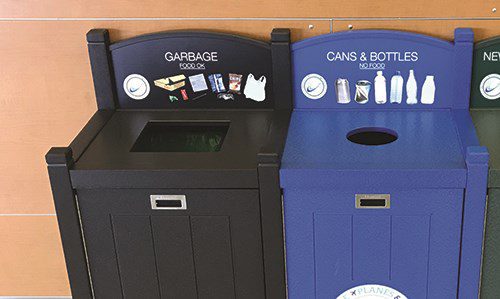Travelers have their minds on many things, but separating their trash and recyclables is not always among them. To get more customers participating in its recycling program, Detroit Metropolitan Wayne County Airport (DTW) is trying to make the process almost automatic.
Travelers have their minds on many things, but separating their trash and recyclables is not always among them. To get more customers participating in its recycling program, Detroit Metropolitan Wayne County Airport (DTW) is trying to make the process almost automatic.
In May, the Wayne County Airport Authority increased its commitment to sustainability at DTW by investing in 45 colored recycling receptacles for the North Terminal, which serves all carriers other than AeroMexico, Air France, Delta Air Lines and KLM Royal Dutch Airlines. The new containers replaced less-visible recycling receptacles that were generally not being used properly.
The new system uses three separate but conjoined receptacles, each with clear identification for what it is designed to hold—trash, cans and bottles, or newspaper and magazines. The airport’s previous recycle bins combined all recyclables together, and they were not labeled as well. Sara Kaplan, the airport authority’s sustainability program administrator, says passengers tended to mix trash with recyclables in the old receptacles.
|
facts&figures Project: Improving In-Terminal Recycling Location: Detroit Metropolitan Airport Strategy: Adding 45 new recycling receptacles with improved labeling in North Terminal to encourage more use Cost: Existing contract with Waste Management Inc. increased 5%-10% to cover additional costs Initiated: May 2019 Of Note: Fully 20% of the 1,550 tons of waste removed from North Terminal in 2016 was recyclable; in 2018, recycling in airport authority offices saved 61 tons of material from local landfills |
“Contamination is one of the biggest challenges with any recycling effort in a public place,” Kaplan says. “The old receptacles were not one unit, so they got moved around a lot and they weren’t easily distinguishable. Now that we have three cans in one place, people are more likely to use them properly.”
The airport placed 42 receptacles throughout the North Terminal, with at least one at each terminal gate. The remaining three containers will be positioned at three gates that will open when DTW’s North Terminal gate and apron expansion project is completed.
The improved recycling effort was kicked off with help from the airport’s trash hauler, Waste Management Inc. A small 5% to 10% increase was incorporated into its contract renewal to cover costs associated with the new equipment/program, notes Kaplan.
A New Look
The new recycling containers are labeled with words as well as pictorial graphics to accommodate travelers who do not read English. When the receptacles were dispatched in May, the airport posted extra signage and set up information tables to provide information about its sustainability effort, including information from the state’s recycling office. Kaplan reports that passengers and airline employees have stopped to learn more.
While it’s too early to know just how well the new system is faring, it was clear the old system was not working well enough. Airport officials say 20% of the 1,550 tons of waste that was removed from the North Terminal in 2016 was recyclable.
“We have received a lot of positive feedback from passengers who are glad to have recycling opportunities,” Kaplan says. Positive comments are also popping up on DTW’s website and social media channels.
Green Goals
The airport authority expresses a commitment to sustainability through its People, Places and Planet program. The initiative focuses on air quality, noise, waste management, water management, energy management and natural resources. In addition to in-terminal recycling, DTW has programs that compost coffee grounds and donate excess food from concessionaires. Parking facilities include equipment for charging electric cars; and water fountains are supplemented with bottle-filling stations.

If the enhanced recycling program continues to be successful in the North Terminal, the airport plans to work with Delta Air Lines to improve recycling in the McNamara Terminal, which serves all flights from Delta and its partners. Kaplan explains that the McNamara Terminal currently has traditional recycling containers in place, and there was a more pressing need for an upgrade in the North Terminal.
In a related matter, the airport authority recently received a state grant to add liquid disposal stations at passenger security checkpoints. The new units are scheduled to be installed by September 2020, and will allow passengers to dump liquids that do not meet TSA requirements but keep the bottles for reuse or recycling. The airport plans to place two or three liquid disposal stations at each of the two passenger checkpoints in the North Terminal, depending on customer traffic.
“We’re always looking for ways to better manage our waste around the airport, including working with our tenants on identifying opportunities to recycle more and reduce our waste,” says Kaplan.
 Chad Newton, chief executive officer of the Wayne County Airport Authority, reinforces the importance of DTW’s sustainability efforts: “We believe environmental stewardship is part of being a good neighbor. Accordingly, we are committed to creating a more sustainable airport.”
Chad Newton, chief executive officer of the Wayne County Airport Authority, reinforces the importance of DTW’s sustainability efforts: “We believe environmental stewardship is part of being a good neighbor. Accordingly, we are committed to creating a more sustainable airport.”
In addition, Newton reports that in 2018, more than 122,000 pounds of recyclable materials were removed from airport authority offices alone—saving 61 tons of paper, metal, cardboard and plastic from being discarded into local landfills.



